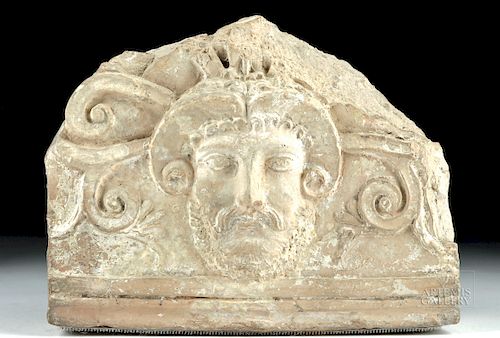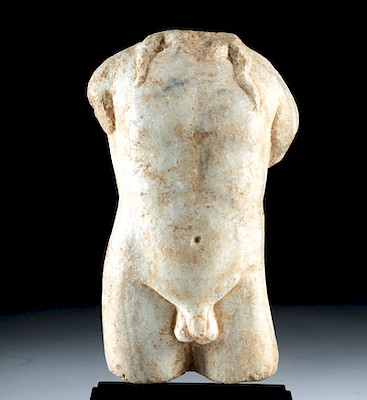Beautiful Etruscan Terracotta Antefix - Tinia (Zeus)
Lot 28d
About Seller
Artemis Fine Arts
686 S Taylor Ave, Ste 106
Louisville, CO 80027
United States
Selling antiquities, ancient and ethnographic art online since 1993, Artemis Gallery specializes in Classical Antiquities (Egyptian, Greek, Roman, Near Eastern), Asian, Pre-Columbian, African / Tribal / Oceanographic art. Our extensive inventory includes pottery, stone, metal, wood, glass and textil...Read more
Estimate:
$2,500 - $3,500
Absentee vs Live bid
Two ways to bid:
- Leave a max absentee bid and the platform will bid on your behalf up to your maximum bid during the live auction.
- Bid live during the auction and your bids will be submitted real-time to the auctioneer.
Bid Increments
| Price | Bid Increment |
|---|---|
| $0 | $25 |
| $300 | $50 |
| $1,000 | $100 |
| $2,000 | $250 |
| $5,000 | $500 |
| $10,000 | $1,000 |
| $20,000 | $2,500 |
| $50,000 | $5,000 |
| $100,000 | $10,000 |
| $200,000 | $20,000 |
About Auction
By Artemis Fine Arts
Dec 5, 2018
Set Reminder
2018-12-05 10:00:00
2018-12-05 10:00:00
America/New_York
Bidsquare
Bidsquare : DAY 1 | Classical Antiquities & Asian Art
https://www.bidsquare.com/auctions/artemis-gallery/day-1-classical-antiquities-asian-art-3698
Day 1 of an important 2-day auction featuring ancient and ethnographic art from around the world. Egyptian, Greek, Roman, Viking, Near Eastern plus Asian Art from China, Japan, Thailand, Vietnam, Burma, India, more. Artemis Fine Arts info@artemisfinearts.com
Day 1 of an important 2-day auction featuring ancient and ethnographic art from around the world. Egyptian, Greek, Roman, Viking, Near Eastern plus Asian Art from China, Japan, Thailand, Vietnam, Burma, India, more. Artemis Fine Arts info@artemisfinearts.com
- Lot Description
Classical World, Italy, Etruria, ca. 4th to 3rd century BCE. A gorgeous architectural antefix, made from a coarse, red terracotta, molded to form a stylized depiction of Tinia (Roman Jupiter / Greek Zeus, also Tin, Tinh, Tins, or Tina), the god of thunder and ruler of Mount Olympus. Zeus presents with a regal visage composed of bulging almond-shaped eyes with drilled pupils under heavy brows, a slender nose between well-defined cheeks, and full lips surrounded by a wavy mustache and a full beard. His head is capped with a curling coiffure beneath a prominent pair of spiraling ram horns. Grooved volutes project from the horns in a windswept manner which complements the deity's elegant illustration. The semicircular back portion has a recessed slot in the middle so it could be attached to the outer edges of roof tops. They were meant to be attractive ornaments as evidence by the thick traces of pink, white, red, and yellow pigment across the front side. Size: 8.25" W x 6.625" H (21 cm x 16.8 cm).
The ancient Etruscans used antefixes to protect and conceal the terracotta tiles along the eaves of a roof, as well as to serve an apotropaic function and ward off bad influences. Antefixes were mold-made and almost always in the form of a male or female head. Many of these were made in the workshops of Caere (Cerveteri) in southern Etruria.
Provenance: private Southern California, USA collection, acquired in the 1970s to mid-1980s
All items legal to buy/sell under U.S. Statute covering cultural patrimony Code 2600, CHAPTER 14, and are guaranteed to be as described or your money back.
A Certificate of Authenticity will accompany all winning bids.
We ship worldwide and handle all shipping in-house for your convenience.
#140820Several areas of restoration including much of the face and nose, left horn, beard, base, and several sections on the volutes, with some resurfacing, retooling of finer details, and light overpainting. Losses to much of top, right side, and verso, with chips and nicks to peripheries, verso, and front, fading and chips to pigmentation, and light encrustations. Nice earthen deposits and traces of original pigmentation throughout.Condition
- Shipping Info
-
All shipping is handled in-house for your convenience. Your invoice from Artemis Gallery will include shipping calculation instructions. If in doubt, please inquire BEFORE bidding for estimated shipping costs for individual items.
-
- Buyer's Premium



 EUR
EUR CAD
CAD AUD
AUD GBP
GBP MXN
MXN HKD
HKD CNY
CNY MYR
MYR SEK
SEK SGD
SGD CHF
CHF THB
THB














